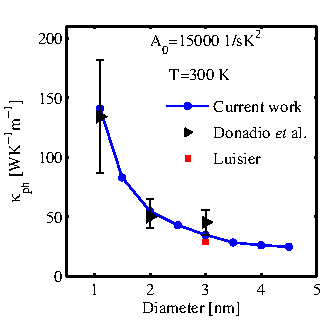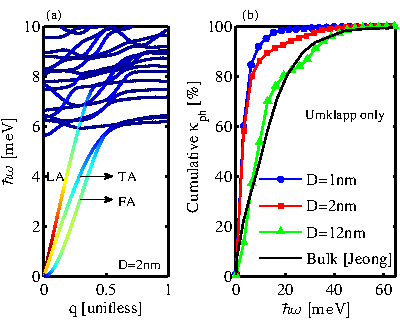
|

|
The importance of the long wavevector phonons, however, is not only pronounced by the length of the channel. The reduction in the diameter of the nanowire can result in the same effect. An important point in Fig. 5.1 is that
nanowires have a finite phonon DOS at low frequencies that also increases as the diameter is reduced, in contrast to bulk. Using the additional scattering mechanism proposed by Mingo et al., and adjusting the parameter ![]() , we calibrated our phonon-phonon thermal conductivity calculations for silicon nanowires against the MD simulation results of Donadio et al. [122] and the results of Luisier [137] for nanowire diameters up to
, we calibrated our phonon-phonon thermal conductivity calculations for silicon nanowires against the MD simulation results of Donadio et al. [122] and the results of Luisier [137] for nanowire diameters up to
![]() as shown in Fig. 5.2. These calculations were performed assuming
as shown in Fig. 5.2. These calculations were performed assuming
![]() and nanowires in the
and nanowires in the
![]() transport direction. The parameter
transport direction. The parameter ![]() of the 3-phonon second order processes was set to
of the 3-phonon second order processes was set to
![]() , which provides a good agreement between our results and these two other studies for the entire diameter range considered. Our results also show good agreement with results from NEGF simulations [137] in a large temperature range (especially above
, which provides a good agreement between our results and these two other studies for the entire diameter range considered. Our results also show good agreement with results from NEGF simulations [137] in a large temperature range (especially above
![]() ), as shown in Fig. 5.3.
), as shown in Fig. 5.3.

|
A clear increase in the thermal conductivity by
![]() is observed as the diameter is decreased. This increase can be directly attributed to the
increasing contribution of the low-frequency longitudinal modes as the diameter is
reduced, since the transmission and DOS acquire a finite value (Fig. 5.1). Indications about thermal conductivity improvements due to phonon confinement can be found in other works as well, for silicon nanowires and other materials [72,98,122,133,138]. This is the first time, however, that this increase is attributed to the finite value that the phonon DOS acquires for the long-wavelength phonons.
is observed as the diameter is decreased. This increase can be directly attributed to the
increasing contribution of the low-frequency longitudinal modes as the diameter is
reduced, since the transmission and DOS acquire a finite value (Fig. 5.1). Indications about thermal conductivity improvements due to phonon confinement can be found in other works as well, for silicon nanowires and other materials [72,98,122,133,138]. This is the first time, however, that this increase is attributed to the finite value that the phonon DOS acquires for the long-wavelength phonons.

|
The importance of the longitudinal modes is indicated in the colormap of Fig. 5.4 which shows the contribution of each phonon state to the thermal conductivity of the
![]() nanowire. The dark-red color of the longitudinal acoustic (LA) mode indicates that most of the heat is carried by this low frequency, low wavevector mode. A large contribution is also attributed to the transverse acoustic (TA) and flexural acoustic (FA) modes. The higher energy quasi-optical and optical modes carry only little heat due to their low phonon group velocities. To quantify the increasing importance of the low
frequency modes with decreasing diameter, Fig. 5.4-b shows the cumulative phonon-phonon limited thermal conductivity versus energy at room temperature. Even in bulk silicon, the low frequency modes carry most of the heat as indicated by the black line from the work of Jeong et al. [57]. Almost half of the heat is carried by phonons of energies below
nanowire. The dark-red color of the longitudinal acoustic (LA) mode indicates that most of the heat is carried by this low frequency, low wavevector mode. A large contribution is also attributed to the transverse acoustic (TA) and flexural acoustic (FA) modes. The higher energy quasi-optical and optical modes carry only little heat due to their low phonon group velocities. To quantify the increasing importance of the low
frequency modes with decreasing diameter, Fig. 5.4-b shows the cumulative phonon-phonon limited thermal conductivity versus energy at room temperature. Even in bulk silicon, the low frequency modes carry most of the heat as indicated by the black line from the work of Jeong et al. [57]. Almost half of the heat is carried by phonons of energies below
![]() . nanowires with larger diameters, e.g.
. nanowires with larger diameters, e.g.
![]() , exhibit similar behavior, as shown by the green line marked by triangles. For thinner diameter nanowires, lower energy phonons become even more important. For
, exhibit similar behavior, as shown by the green line marked by triangles. For thinner diameter nanowires, lower energy phonons become even more important. For
![]() and
and
![]() ,
, ![]() of the heat is carried by phonons with energies below
of the heat is carried by phonons with energies below
![]() .
.